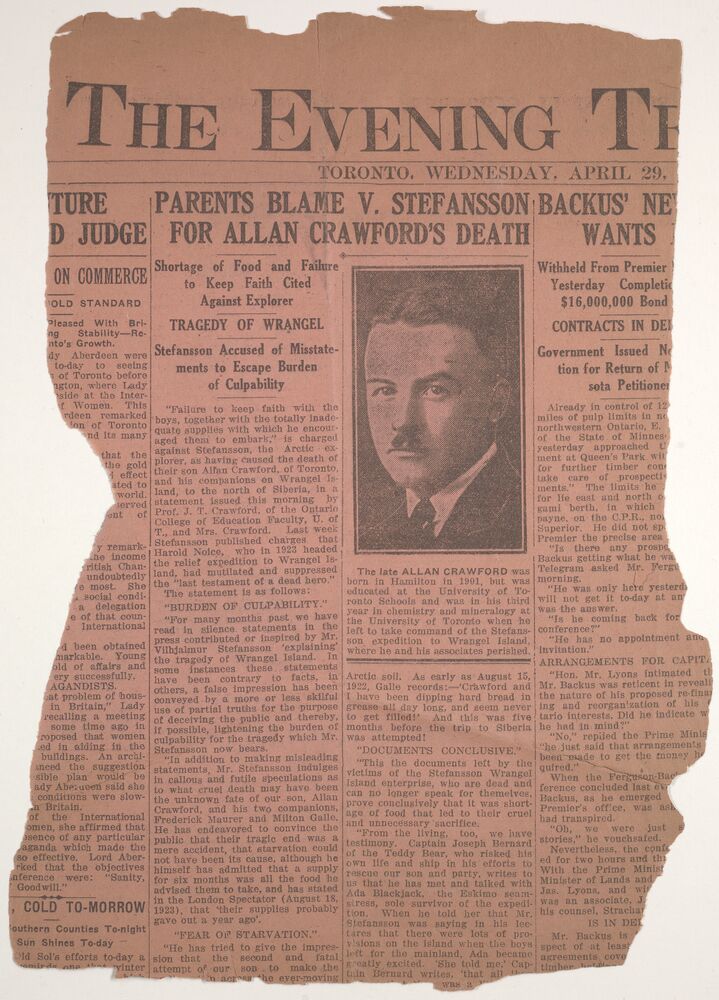Disaster Aftermath

The Wrangel Island expedition, led by the young Canadian explorer Allan Crawford under the auspices of the Arctic explorer Vilhjalmur Stefansson, remains one of the most tragic tales of exploration in the early 20th century. This essay aims to delve into Stefansson's role in the expedition, the consequent demise of its members, and reflect on the broader implications of this ill-fated venture.
Stefansson's Role and Responsibility
Vilhjalmur Stefansson, a renowned Arctic explorer, was the architect of the Wrangel Island expedition, designed to claim the uninhabited island for Canada. Stefansson's reputation was built on his previous Arctic expeditions and his belief in the viability of living off the harsh Arctic environment. However, his involvement with the Wrangel Island expedition has been marred by controversy, primarily due to his decision-making and the support he provided to the team he sent.
Stefansson recruited a team of young, relatively inexperienced adventurers, including Allan Crawford, Frederick Maurer, Milton Galle, and Lorne Knight, promising them an adventure that would cement their names in the annals of Arctic exploration. However, Stefansson's role was more of a distant overseer than an active participant. He remained in the comforts of civilization, engaging in lectures and promoting his Arctic endeavors, while his team faced the brutal realities of Arctic survival.
The core of the criticism against Stefansson centers on his failure to supply the expedition adequately and his absence during the critical phases of the venture. The expedition was equipped with only six months' worth of provisions, despite plans for a longer stay. Stefansson's optimism about "living off the land" in the Arctic proved disastrously naive. As highlighted in the statements from the Crawfords, Stefansson's encouragement for the expedition under such conditions directly contributed to its tragic outcome. The article vividly illustrates the profound disconnect between Stefansson's promises and the grim realities faced by the expedition team, underpinning his downfall from a respected explorer to a figure of controversy and blame. The public outcry, particularly from the families of the expedition members, as detailed in the article, highlights the perceived betrayal by Stefansson. The Crawfords' statement, accusing Stefansson of failing to keep faith with the boys and providing totally inadequate supplies, serves as a damning indictment of his role and responsibility in the tragedy. This accusation is supported by the harrowing accounts of starvation and hardship documented by the expedition members, contradicting Stefansson's public assertions about the expedition's preparedness and prospects.
Conclusion
The details from the article not only support but deepen the understanding of Stefansson's downfall. His misjudgments, failure to adequately prepare and support the expedition, and attempts to shift blame posthumously illuminate the tragic consequences of his leadership. The Wrangel Island expedition, as recounted by the victims' families and supported by documentary evidence, offers a somber narrative on the complexities of exploration, the importance of ethical leadership, and the unforgiving nature of the Arctic. Stefansson's legacy, tarnished by this event, serves as a cautionary tale for future generations about the costs of negligence and the paramount importance of responsibility in the face of human ambition. Stefansson's role in the Wrangel Island expedition is a complex blend of ambition, negligence, and tragic consequence. While his contributions to Arctic exploration are undeniable, his involvement in this particular venture serves as a somber reminder of the costs associated with exploration at the expense of human life. The legacy of the Wrangel Island expedition, marred by the needless loss of its members, invites reflection on the broader themes of exploration, responsibility, and the human spirit's resilience and vulnerability in the face of nature's indomitable forces.
